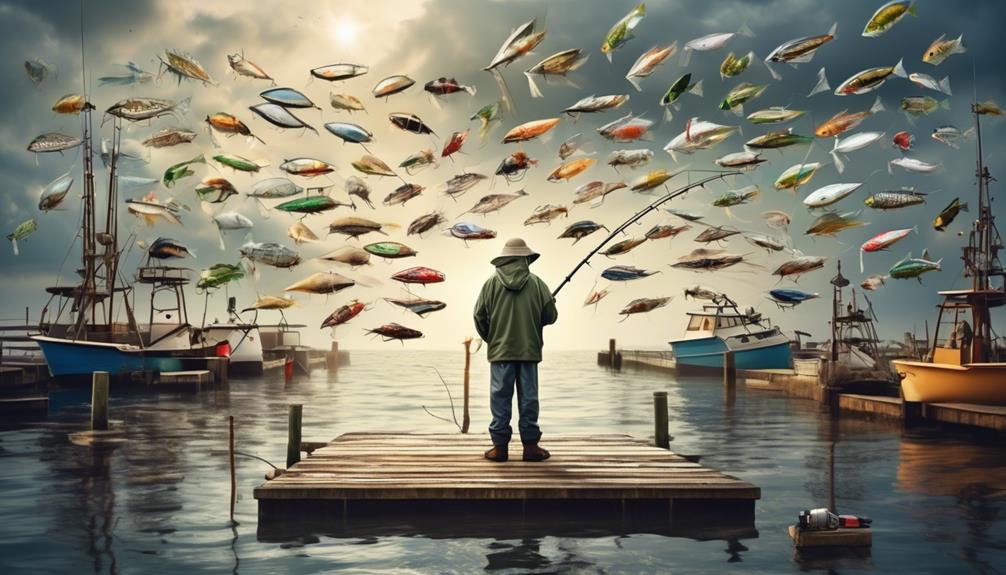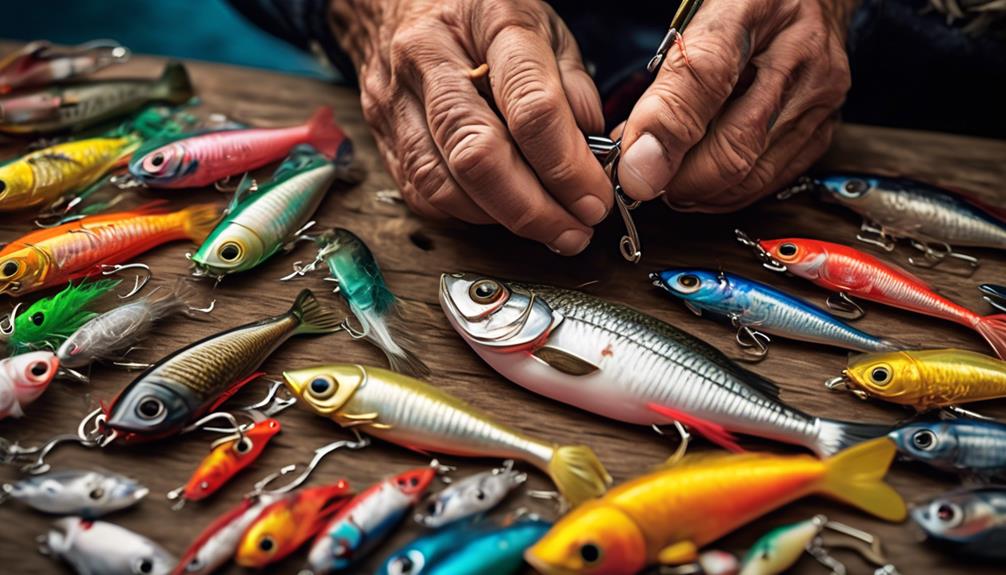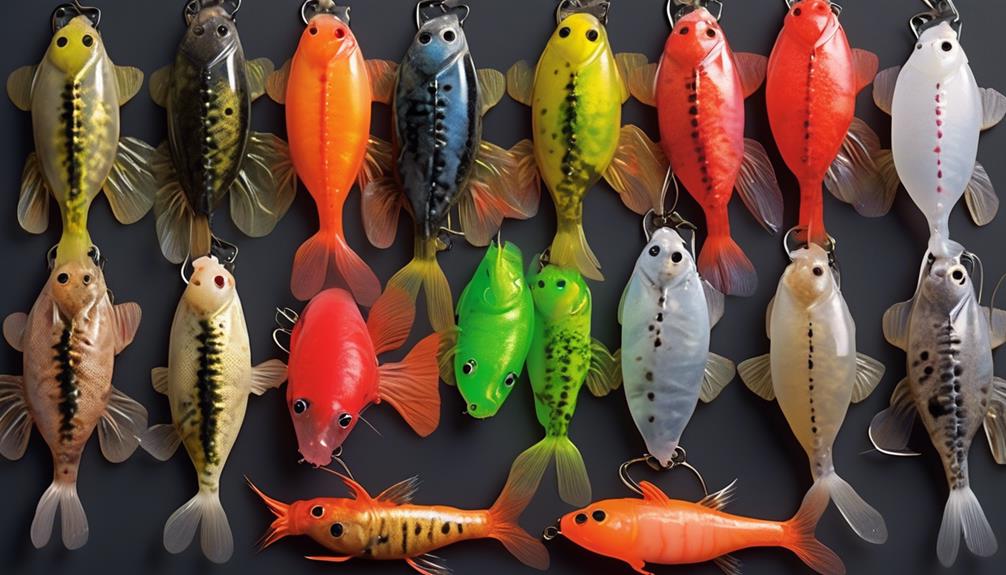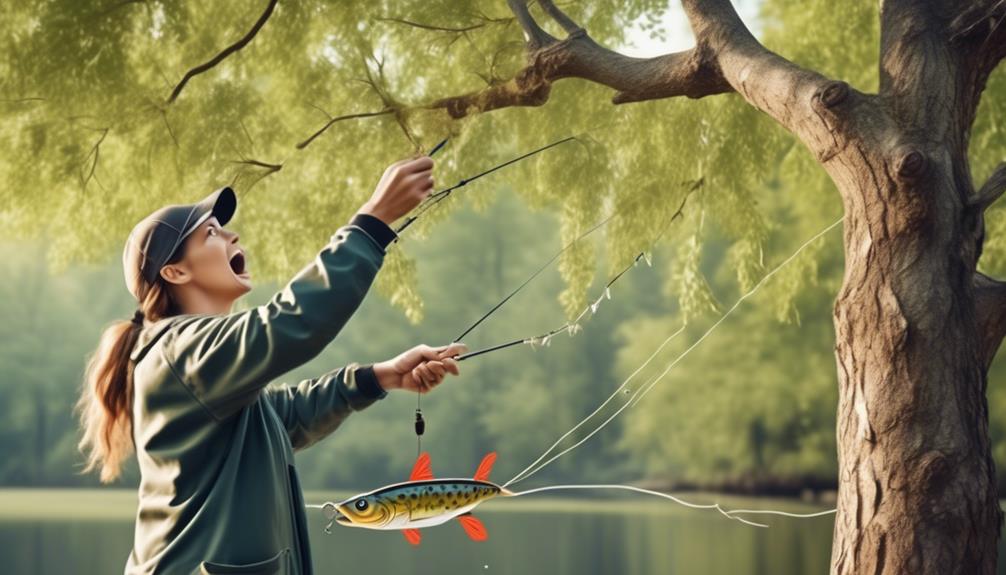When it comes to fishing, the success of your day on the water can often be determined by the weather conditions. Whether it's the bright sunshine or the heavy rain, each weather pattern presents its own set of challenges and opportunities for anglers.
Understanding how to tailor your fishing lures to match the prevailing weather conditions can make all the difference in your catch rate. So, how exactly do you adjust your lures to optimize your chances of reeling in the big one?
Let's explore the art of choosing the right lures for different weather scenarios.
Sunny Weather Lures
When fishing in sunny weather, opt for lures that feature reflective surfaces to attract the attention of fish. In clear water and shallow waters, the sunlight can penetrate deeper, making reflective lures particularly effective. These lures mimic the natural flashes of light that occur when fish prey swims in the water, making them irresistible to nearby fish.
The use of reflective lures is especially advantageous in clear water conditions, where fish have a clear line of sight and can easily spot their prey from a distance.
In sunny weather, it's essential to choose lures that can grab the attention of fish even in bright, well-lit conditions. The reflective surfaces on lures help to create a shimmering effect, making them stand out in the water and piquing the curiosity of nearby fish.
When fishing in shallow waters, where the sunlight can penetrate and create a sparkling effect, these reflective lures are even more effective. They capitalize on the natural light and draw fish in, increasing your chances of a successful catch.
Cloudy Weather Lures
In contrast to the reflective lures favored in sunny weather, cloudy conditions call for lures with more vibrant colors and erratic movements to attract the attention of fish. In low light and visibility challenges, it's essential to adapt your lure choice for optimal fishing success.
When the skies are overcast, consider the following tips to enhance your fishing experience:
- Bright Colors: Opt for lures in bright and bold colors such as chartreuse, orange, and pink. These vibrant hues stand out in the dimmer light, making it easier for fish to spot your lure amidst the murky waters.
- Erratic Action: Choose lures that offer erratic movements to mimic the behavior of disoriented prey. This can include lures with a jerking, darting, or unpredictable swimming action, which can be particularly enticing to fish in overcast conditions.
- Contrast: Look for lures with a high level of contrast, such as those with a dark back and a light belly. This contrast helps the lure remain visible and distinguishable to fish, even when the light is limited.
Rainy Weather Lures
For optimal fishing success during rainy weather, consider using lures with exaggerated movements and highly visible colors to attract fish in low light conditions. When it comes to wet weather techniques, adapting your lure choice can significantly improve your chances of a successful fishing trip.
Rainy conditions can make it more challenging for fish to spot your bait, so using lures with vibrant and eye-catching colors is essential. Additionally, lures with exaggerated movements, such as those with spinning blades or paddle tails, can create more attention-catching vibrations in the water, making them more noticeable to fish despite the decreased visibility.
Incorporating water-resistant bait options into your rainy weather fishing arsenal is crucial. Look for lures made from materials that can withstand prolonged exposure to water without losing their effectiveness. This can include using lures with durable plastic or metal components that won't rust or degrade quickly in wet conditions.
Furthermore, consider utilizing lures with sealed designs or coatings that help repel water, ensuring that they maintain their lifelike appearance and action even during heavy rain.
Windy Weather Lures
Considering the challenges posed by changing weather conditions, adapting your lure selection becomes crucial in windy weather. When facing strong winds, it's important to adjust your casting techniques to ensure your bait is effective. Additionally, choosing the right bait that can withstand the wind and still attract fish is essential. Here are some tips to help you make the most of windy weather fishing:
- Use heavier lures: Opt for heavier lures as they're less affected by the wind and will allow you to cast more accurately and maintain control over your presentation.
- Focus on aerodynamic lures: Look for lures with a streamlined and aerodynamic design. These lures will cut through the wind more easily, reducing the impact of gusts on your casting.
- Employ topwater lures with rattles: In windy conditions, using topwater lures with built-in rattles can be effective. The sound produced by the rattles will help fish locate the lure despite the wind-disturbed waters.
When it comes to bait selection, certain baits are more suitable for use in strong winds:
- Spinnerbaits: These baits can be very effective in windy conditions due to their ability to be retrieved quickly and their resistance to wind interference.
- Crankbaits: Crankbaits are great choices for windy weather as their diving action allows them to reach the desired depth even in windy conditions, making them particularly versatile.
- Spoons: Spoons are heavy and can be cast against the wind, making them a good choice when dealing with strong gusts.
Overcast Weather Lures
When fishing in overcast weather, selecting lures designed to enhance visibility and movement can significantly improve your chances of attracting fish. In these conditions, it's crucial to consider lure color and visibility. Brightly colored lures such as chartreuse, orange, or pink can stand out against the dark backdrop of overcast skies, making them more visible to fish. Additionally, using lures with reflective or metallic finishes can help increase visibility by catching and reflecting any available light, thus increasing their appeal to fish in the lower light conditions of overcast weather.
In overcast weather, lure movement and depth are also important factors to consider. Fish may be more active and closer to the surface in overcast conditions, so lures that can be worked effectively at shallower depths may yield better results. Topwater lures, such as poppers or surface-walking baits, can create enticing movement and disturbance on the water's surface, making them ideal for overcast conditions.
Additionally, lures with a natural swimming action, like swimbaits or soft plastic jerkbaits, can be effective in overcast weather as they mimic the movement of live bait, attracting fish in the process.
Stormy Weather Lures
In stormy weather, as the visibility decreases and the water becomes turbulent, selecting lures that can withstand rough conditions and still attract fish is crucial for increasing your chances of a successful catch.
When facing stormy weather while out fishing, remember that the fish are still active and feeding, but you need to adjust your approach to match the conditions.
Here are some essential tips for choosing the right lures during stormy weather:
- Brightly Colored Lures: In stormy conditions, the water can become murky and dark. Using brightly colored lures can help attract fish by increasing visibility and catching their attention despite the low light conditions.
- Lures with Rattles or Vibrations: Turbulent waters can disrupt a fish's ability to locate prey through sight alone. Lures with built-in rattles or vibrations can help fish locate your lure by relying on their other senses, such as sound and vibration.
- Heavy and Durable Lures: Stormy weather often means strong tidal patterns and rough waters. Using heavy and durable lures will help you work against the strong currents and ensure that your lure remains intact and effective in challenging conditions.
Considering tidal patterns and water temperature is also crucial when choosing lures for stormy weather. Understanding how the storm affects these factors can guide your lure selection and increase your chances of a successful catch.
Foggy Weather Lures
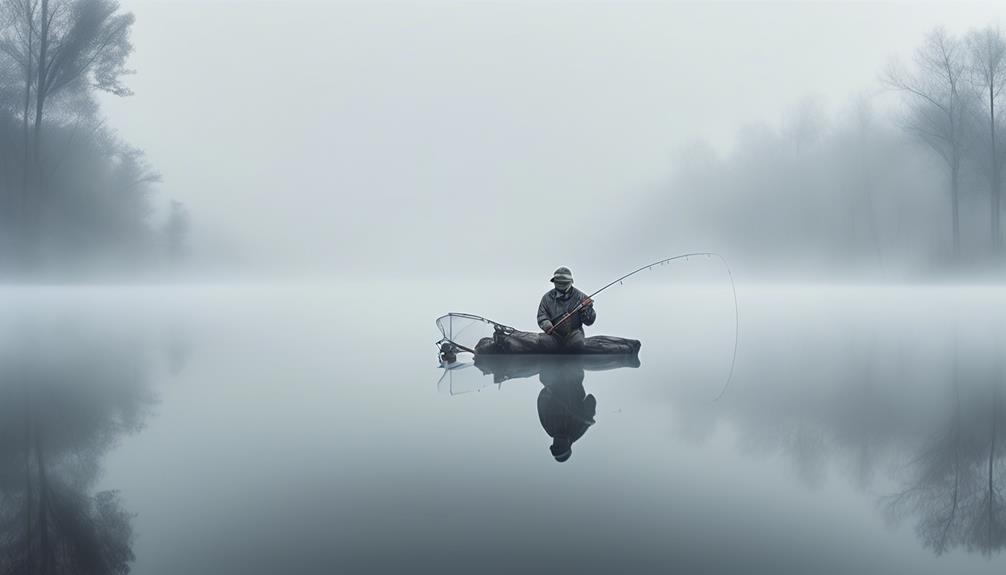
For foggy weather conditions, opt for lures with high-contrast colors to enhance visibility and attract fish despite the reduced light. In foggy weather, visibility is limited, and fish rely more on their ability to detect movement and contrast to locate prey. Using lures with bright colors like chartreuse, orange, or fluorescent red can make them stand out in the water, increasing their visibility to fish. Additionally, incorporating reflective or metallic elements into the lures can help them catch and reflect whatever light is available, further increasing their visibility in the foggy conditions.
When fishing in foggy weather, it's essential to adjust your techniques to suit the conditions. Topwater lures can be particularly effective as they create commotion on the surface, making them easier for fish to locate. Using lures with rattles or other noise-making features can also help fish hone in on the lure despite the limited visibility. It's crucial to focus on creating disturbances that will draw fish towards your bait. Slow and steady retrieves can also be beneficial, as they give fish more time to detect and react to the lure in the reduced visibility of foggy weather.
In foggy weather, utilizing lures that maximize visibility and employing the right fishing techniques can significantly increase your chances of a successful catch. By understanding the impact of foggy conditions on visibility and adjusting your lure selection and fishing style accordingly, you can enhance your fishing experience even in challenging weather.
Snowy Weather Lures
To adapt your fishing approach for snowy weather, prioritize lures with high-contrast colors and reflective elements to compensate for reduced visibility and effectively attract fish despite the challenging conditions.
Winter fishing and ice fishing techniques require specialized lures to entice fish in snowy conditions. Here's what you need to know:
- High-Contrast Colors: Opt for lures in vibrant colors like bright red, neon green, or orange to stand out against the white backdrop of the snow. These high-contrast colors increase visibility for the fish and make it easier for them to spot your lure.
- Reflective Elements: Choose lures with reflective elements such as holographic finishes or metallic accents. These reflective properties mimic the sunlight reflecting off the snow, catching the fish's attention and drawing them towards your lure.
- Slow-Moving Lures: In snowy weather, fish are often less active due to the cold temperatures. Using slow-moving lures like jigs or soft plastics can be more effective as they give the fish time to react and strike, even in sluggish conditions.
When ice fishing in snowy weather, it's essential to use lures that appeal to the fish's senses despite the limited visibility. By incorporating high-contrast colors, reflective elements, and slow-moving lures into your winter fishing and ice fishing techniques, you can increase your chances of a successful catch even in the midst of a snowy landscape.
Frequently Asked Questions
Can Fishing Lures Be Used in All Types of Weather Conditions?
Yes, fishing lures can be used in all types of weather conditions. The key is selecting the right lure based on the weather impact.
Different weather conditions can affect fish behavior, so adjusting your lure selection to match the conditions can increase your chances of success.
For example, in sunny weather, bright and reflective lures can be more effective, while in overcast or rainy conditions, darker and more subtle lures may work better.
Are There Specific Types of Fish That Are More Active in Certain Weather Conditions?
Certain types of fish are more active in specific weather conditions. Weather can impact fish behavior, influencing their feeding patterns and movement.
For example, some fish are more active during overcast days, while others prefer clear, sunny weather. Understanding how different weather conditions affect fish behavior can help you tailor your fishing approach to maximize your chances of a successful catch.
Do Different Weather Conditions Affect the Behavior of Fish, and How Does This Impact Lure Selection?
Different weather conditions can greatly impact fish behavior. When it's sunny, fish may move to deeper, cooler waters, while during overcast or rainy days, they might be more active near the surface. Wind can also affect where fish congregate.
Understanding these weather patterns can help you choose the right lures. For example, on a windy day, using a lure that imitates a distressed baitfish may yield better results.
Are There Any Specific Safety Precautions Anglers Should Take When Fishing in Extreme Weather Conditions?
When fishing in extreme weather conditions, it's crucial to prioritize weather safety.
Keep an eye on the forecast, and be prepared for any changes. Dress appropriately for the weather, and consider wearing a life jacket if you're fishing in rough waters.
It's also important to have a plan in case of emergencies and to let someone know your fishing plans and expected return time. Always put safety first when facing extreme conditions.
How Can Anglers Adjust Their Fishing Techniques to Adapt to Changing Weather Conditions?
When weather changes, adapting techniques is crucial for successful fishing. Weather impacts fish behavior and feeding patterns.
In sunny conditions, use bright, flashy lures to attract fish. In cloudy or rainy weather, opt for darker, more natural-looking lures. Adjust your retrieval speed based on wind and water current. Experiment with different depths and locations to find where fish are hiding.
Conclusion
In conclusion, tailoring your fishing lures to match the weather conditions can greatly improve your chances of catching fish. By understanding which lures work best in sunny, cloudy, rainy, windy, overcast, stormy, foggy, and snowy weather, you can adapt your fishing approach for maximum success.
Remember to always consider the weather when selecting your lures and be prepared to switch them out as conditions change.
Happy fishing!
